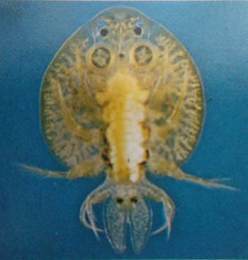| Back to Back Issues Page |
 |
|
The Goldfish Gazette, Issue #064 -- Parasites Revisited April 30, 2019 |
Goldfish Care TipsA Free Monthly Resource For Goldfish Enthusiasts In This Issue
Goldfish as a species seem to be particularly affected by a range of parasites, especially when they are young. Parasites Revisited
We know Goldfish are hardy fish that can tolerate a wide range of water conditions, and if a few simple rules for their care are followed, they seldom get sick. But, despite our best efforts, sometimes our fish start to exhibit strange behaviors such as fin twitching and flashing (scraping themselves against objects in the aquarium or pond). Other more serious behaviors are becoming lethargic or loss of appetite. If water conditions are good, then you can suspect parasites. Types of ParasitesThere are three broad categories of parasites:1. Crustacean The two most common fresh water crustaceous parasites are anchor worm (Lernaea cyprinacea) and lice (Argulus). These are the biggest of the parasites, but probably the least dangerous because they can be seen by the naked eye. Lice are 1/8th (3mm) in diameter, translucent to light green in color and look like flying saucers attached to the fish’s body. Anchor worms look like small harpoons sticking into the side of the fish and can be white, yellow, tan or dark green in color. Both these parasites prefer clean water and healthy hosts. The health of your fish has no bearing on whether they will be attacked. If the parasite is introduced into their environment, they will become infested. These parasites suck the blood of the host. There are only two ways these parasites are introduced, either from new arrivals, or on water plants. The more common parasitic infestation is worms. The two most prevalent are gill flukes (Dactylogyrus) and body flukes (Gyrodactylus). Both these worms can be present on either the body, or within the gills. They are a problem for fish under 2” or 52mm body length because their protective coating isn’t thick enough to resist them. Gill flukes are particularly dangerous to fry. They can wipe out an entire brood within days. These parasites feed on the body slime of their hosts, but it is the attaching to the skin that causes the damage. This often causes an outbreak of fungus or ulcers. These worms are very hard to see, almost impossible on a red/gold colored fish, but can be seen on Black Moor as tiny white worms, the largest about 1mm long. Flukes are introduced with new arrivals or, if they are already in your fish population, any fish with a low immune system will be attacked. The last group of parasites are the protozoan parasites such as Costia, Hexamita and Ich. These are the smallest parasites, and apart from Ich, can only be diagnosed accurately with a microscope. They burrow into, and feed on, the top layers of skin cells. These parasites will attack any sized fish with a weakened immune system. They multiply rapidly, and if treatment isn’t administered quickly, fish will be killed within days. Costia is often the cause of unexplained pond fish deaths in spring. QuarantiningMost Goldfish websites advise quarantining new arrivals for between 2-4 weeks, advice that I totally agree with.What most websites don’t say is, treat the fish for parasites whether they are showing symptoms or not. If you buy a new fish, and it is healthy, just quarantining the fish in a mild salt bath for 4 weeks won’t kill any parasites. This fish may be carrying very small numbers of flukes and protozoan parasites. A healthy fish doesn’t mean a parasite free fish. When this healthy fish is introduced into an existing community of fish, suddenly there is an outbreak of parasites. Why is this when the existing community of fish are also healthy? It is because the existing community of fish may have had little or no exposure to the new parasites, therefore little immunity. TreatmentsThere is good news.All these parasites are now easily treated with off the shelf medications. Two treatment options are available depending on the parasites: 1. Crustaceous parasites (lice, anchor worms) The treatment for crustaceous parasites will contain ingredients such as n-cyclopropyl-1, 5-triazine-2 and cyromazine. The rest of the parasites can all be treated with a Praziquantel based medication. Praziquantel will also treat internal worms. SummaryMedicate all new arrivals as if they have parasites.For more information on parasite medications available, click here… Comments? Ideas? Feedback? I'd love to hear from you. Just reply to this e-zine and tell me what you think, or what topics you want covered. Next Month's Topic Floaty Fishwww.facebook.com/aboutgoldfish |
| Back to Back Issues Page |